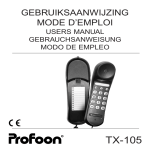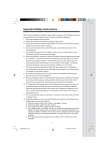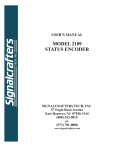Download Profoon TX-230 Specifications
Transcript
USERS MANUAL TX-168PHB DECLARATION OF NETWORKCOMPATIBILITY The Profoon TX-168PHB is designed for use on the ‘public switched telephone networks (analogue single-line)’ of telephone- and cable-companies inside the Benelux. Each country and/or provider might require a different telephoneplug. The Profoon TX-168PHB complies with the essential requirements and provisions as described in the European Directive 1999/5/EC. The function Caller-ID is based on both the DTMF and the FSK system (automatic detection). It might be possible that you have to subscribe to this feature. DECLARATION OF CONFORMITY The declaration of conformity is available on the website WWW.PROFOON.COM INTRODUCTION The Profoon TX-168PHB is a telephone with built-in Caller-ID: the name (when supported by the provider or when stored in the memory) and the number of the person who is calling to you, comes on the display of your telephone. The Caller-ID memory has a capacity of 30 calls, including the time and date of the call. The Caller-ID is linked with the dialer of the telephone. Any incoming call can be called black. The TX-168PHB has a phonebook memory of 35 numbers with names and the numbers can be dialed handsfree. 2 INSTALLATION Power supply: The TX-168PHB needs power to operate. Use the included power adaptor or install 4x 1,5 Volt battery, size AAA. Power adaptor: One power adaptor is included. Use this one or a version with the following specifications: input: 230 Volt, 50, Hz AC output: 6 - 9 Volt DC, 200mA, Batteries: open the battery compartment (direct below the handset) and install 4 pcs 1.5V AAA batteries. Mind the polarity. Batteries are not included. Attention: always disconnect the telephone form the telephone outlet when batteries are to be installed or replaced. See also page 11. Telephonecord & handsetcord: 1. connect the supplied handsetcord between the handset and base 2. connect the telephonecord to the backside of the telephone; push the connectors till you hear a click 3. plug the telephone plug into your telephone outlet Wall mount: 1. drill two holes in the wall with a distance of 9cm and insert two screws; let the heads of the screws stick out a few millimeters of the wall 2. remove the handsetholder, rotate it 180° and replace it; this holder will hold the handset when wall mounted 3. hang the unit on the wall and fixate the telephone wire by means of cable-clips Once the power adaptor is plugged into a 230V mains outlet and / or the batteries have been installed, the telephone is ready for use. 3 ADJUSTING Language: 1. press MENU 4 times, the display indicates “TAAL” (= language) 2. press YES, the display gives “NEDERLANDS” (= Dutch) 3. use or to select “ENGLISH” 4. press YES Time: 1. press MENU 2 times, the display indicates “CLOCK” 2. press YES, the hour indication starts to blink 3. use and to adjust the hours and press YES, the minute indication starts to blink 4. repeat this procedure for the month and the date 5. press BACK to finish the adjusting Contrast: 1. press MENU 3 times, the display indicates “CONTRAST” 2. use and to select the required contrast (position 0 is minimum contrast, position 7 is the maximum contrast) 3. press BACK to finish the setting 4 HOW TO USE Incoming call: Adjust the ringer volume with the ringer switch on the backside of the telephone. Lift the handset and start the conversation. Outgoing call: Lift the handset. Wait for the dial tone and key-in the desired telephone number. Handsfree dialing: 1. press the button HANDSFREE to switch-ON the handsfree mode; the dialtone is heard through the built-in loudspeaker and can be controlled by the slider on the right side 2. key-in the desired telephonenumber 3. as soon as the called party answers the call, lift the handset to start the conversation Last number memory: The TX-168PHB keeps track of the 9 last dialed numbers: 1. press REDIAL/P and the last dialed number will come on the display 2. press to see the last but one dialed number 3. use and to step through the last number memory 4. as soon as the required number is on the display, lift the handset or press the speakerbutton to AUTOMATICALLY dial the number Remarks: * Only with the handset on the cradle, you can step through the last number memory (press button BACK to return to the idle state). * In case you press button REDIAL/P when the handset is lifted, the last dialed number will be redialed. * In case a number, which is for example the 5th number in the last-redial-list, will be redialed, this number will now move to the last position. Pause: In case you are connected through a PABX, a waiting time must be inserted direct after the prefix number. Press the REDIAL/P button to insert a pausetime. Call transfer and network-services: Use the FLASH key to activate special services from your telephone-company or to transfer a call in case you are connected through a PABX. The FLASH time of the TX-168PHB is 100mS. 5 Teleservices: Buttons and # are functionbuttons, needed for divers telecom-services (teleshopping, telebanking, etc) or to control divers telecom devices (PABX, answering machines, etc). Refer to the concerning manual. Calltimer: As soon as the handset is lifted or the speakerbutton is pressed, the calltimer keeps track of the call time. 6 MEMORY The TX-168PHB has a memory capacity of 37 names and numbers: * Each name can be as long as 15 characters. * Each number can be as long as 16 digits. * 2 Memory locations are one-touch memories; use them for emergency numbers. * The remaining 35 memory locations are accessible through the phonebookmenu. * See chapter Pause on page 4 in case a dialpause is required. * It is possible to copy numbers, received by the TX-168PHB’s Caller-ID, into the dialmemory. In case the system also sends the name, this name will be copied too. Programming M1 & M2: 1. leave the handset on the telephone 2. press M1 or M2; in case already a name and number was programmed, the display shows this number else only the time and date is displayed 3. press PROG, the upper-left segment will be selected (blinking stripe) 4. key-in the name (see further on) and press YES 5. key-in the telephone number and press YES Programming phonebook memories: 1. leave the handset on the telephone 2. press MENU; the display indicates “PHONE BOOK” 3. press PROG; the display gives “XX ENTRIES”; xx stands for the number of memories which are already stored 4. press YES, the upper-left segment will be selected (blinking stripe) 5. key-in the name (see further on) and press YES 6. key-in the telephone number and press YES Programming of the name: Use the dialbuttons to compose the name. Example: press 2x button 3 to get the E, press 3x button 5 to get the L, etc. use button to move the cursor to the right or to insert a space use button to move the cursor to the left use button CLEAR to erase the selected character Dialing M1 or M2: 1. lift the handset or switch to handsfree dialing and wait for the dialtone 2. press M1 or M2 3. the number will be dialed 7 Dialing phonebook memories: 1. leave the handset on the telephone 2. press MENU, the display indicates “PHONE BOOK” 3. press YES, the display gives “NAME ?” 4. use and to step through the phonebook 5. press, when he required name is on the display, the speakerbutton to dial the number 6. as soon as the called party answers the call, you have to lift the handset to start the conversation Attention: the dialing of a phonebook entry can only be done in handsfree mode (see above instruction 5). Only after the dialing of the number has began, you may lift the handset. Correction: 1. press MENU, the display indicates “PHONE BOOK” 2. press YES and look for the name/number, using the buttons and 3. press PROG, the first character of the selected name blinks 4. press repeatedly CLEAR to erase the name and key-in the new name and press YES 5. use CLEAR to erase the number, key-in the new number and press YES to store the new entry Erase: 1. press MENU, the display indicates “PHONE BOOK” 2. press YES and look for the name/number, using the buttons and 3. press CLEAR, the display indicates “DELETE ?” 4. press YES to delete the selected name/number or press BACK to return to the idle state 8 CALLER-ID Functioning: Together with the first ring, the Telephone Company sends the telephonenumber of the person who is calling to you. This can also be the telephonenumber of a fax or of a mobile phone. On receipt of this information, the display of the TX-168PHB shows this number and stores it into its memory. Because the numbers are stored in memory, at any time you can see who called you and at what time and day. The display indicates how many calls are in memory and how many calls are received after the last time you viewed the numbers. Please note that you must subscribe yourself for Caller-ID. Contact your provider. Memory: The memory can hold 30 incoming calls (numbers + names). When the memory is full, each new incoming call will overwrite the oldest call. Please make sure to regular read the memory and to delete it contents. The display indicates how many calls are in memory (TOTAL) and how many of them have not been read yet (NEW). Name: In case you receive a call from someone which name and number you have stored in the phonebook memory of the TX-168PHB, then the name you programmed in your telephone will come on the display. Else the name which is transmitted from the provider will be displayed. In case the provider only sends the number and you have not stored this number in your telephone, than only the number will come on the display. Repeated call: A repeated call will be displayed as "RPT" in the display. The information concerning the first call will be lost, only the time and date of the last call will be memorized. Time/date: The time and date of each call are memorized too. In case your provider uses the FSK Caller-ID system, the network provides the time/date information. In case your provider uses the DTMF system, the time/date of the internal clock of the TX-168PHB will be used. 9 Read the memory: Press or to start reading. Use buttons or to step through the memory. Next to “CALL#”, the rotation number of that call is displayed. The lower part of the display gives the time and date of that call. Call back: 1. leave the handset on the cradle and use or to look for the number to be dialed 2. as soon as the required number is on the display, press YES; the number will be dialed 3. you may now lift the handset to start the conversation Erase specific numbers: 1. leave the handset on the cradle and press or to look for the call to be deleted 2. press CLEAR, the display indicates “DELETE ?” 3. press YES to erase the selected call or press BACK to return to the idle state Erase all: 1. leave the handset on the cradle and press or to start reading the memory 2. press CLEAR and keep this button depressed until the display indicates “DELETE ALL ?” 3. press YES to erase all calls or press BACK to return to the idle state Store received numbers into the phonebook: 1. leave the handset on the cradle and look for the number, using and 2. press PROG 3. press M1 or M2 to store the number in one of the one-touch memories or press YES to store the number in the phonebook 10 TIPS & REMARKS Batteries: In case the battery-LO indication lights, the batteries have to be replaced. When the batteries need to be replaced, act as follow: 1. disconnect the telephone from the telephone outlet 2. press key MENU 5 times, the display shows “REPLACE BATT” 3. press YES, the display shows “SYSTEM HALT” 4. replace the batteries within ONE minute 5. press MENU until the display gives the time/date 6. reconnect the telephone with the telephone outlet Do not just throw away empty batteries but hand them over to your local depot for chemical waste. Always disconnect the telephone from the telephoneline when replacing the batteries. PABX: In case the TX-168PHB will be connected to a PABX, check if the PABX is suitable for Caller-ID. If not, the TX-168PHB has to be connected directly to the public telephone network. ISDN: The TX-168PHB only display's the number of the caller when the used ISDN exchange is suitable for CLIP for analogue telephones Call waiting: If during a telephone-call a new call comes in, the number of this second call will not be displayed. VoiceMail / PhoneMail: System FSK: In case your provider supports VM facilities and you receive a mail, than the VM symbol (envelope) on the display will light. After you have listened to the mail, the provider will take care that this indication goes off. System DTMF: The DTMF system is not that intelligent that it can light the VM symbol. You can however look in the Caller-ID memory. In case no one called you, then there will also be no voicemail. Be advised that if someone called you and might be routed to your voicemail, he or she might not have left a message. 11 MAINTENANCE Do not locate the telephone in direct sunlight or in a moist environment. Never use chemical cleansers to clean the cabinet, the cabinet may only be cleaned with a moist cloth. Don't place the TX-168PHB on furniture with cellulose based coating; the rubber feet will leave stains on the cellulose. Under certain circumstances the sound of the TX-168PHB might be influenced by electromagnetic fields of electronic devices like TV, computer or radio transmitters close to the telephone. Relocate the telephone to gain better results in such cases. 12 GUARANTEE CARD CUSTOMER: Name: Address: Zip-code: City: Telephone: attach here your purchase ticket You have a guarantee of 12 MONTHS after the date of purchase of this Telephone. We guarantee during this period the free repair of defects caused by material- and construction faults. This at the importers discretion. It is only possible to claim to the guarantee when you enclose your purchase ticket with the TX-168PHB. HOW TO ACT: If you notice a defect, consult the manual first. If this manual gives you no definite answer, consult your dealer with a clear description of your complaint. He will collect the device together with this guarantee card and the dated purchase ticket and he will take care of a prompt repair, respectively free sending to the importer. THE GUARANTEE EXPIRES: When used inexpert, faulty connections, leaking and faulty placed batteries, use of unoriginal parts or accessories, negligence and defects caused by fire, flood, stroke of lightning and natural disasters. With unqualified modifications or repairs by third persons. With incorrect transport without a suitable packing. If the device is not handed in with the correct filled in guarantee card and the purchase ticket. NOT UNDER THIS GUARANTEE: cords, plugs and batteries. All further responsibilities, in particular subsequent damages, are excluded. 13























